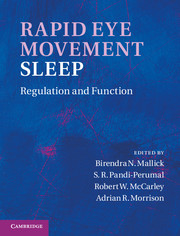Book contents
- Frontmatter
- Contents
- Contributors
- Preface
- Acknowledgments
- Organization
- Section I Historical context
- Section II General biology
- Section III Neuronal regulation
- 10 Understanding REM sleep: clues from brain lesion studies
- 11 Preoptic and basal forebrain modulation of REM sleep
- 12 Amygdalar regulation of REM sleep
- 13 Pontomedullary mediated REM-sleep atonia
- 14 Phenomenology and function of myoclonic twitching in developing rats
- 15 Pontine-wave generator: a key player in REM sleep-dependent memory consolidation
- 16 Hippocampal theta rhythm of REM sleep
- 17 Respiration during REM sleep and its regulation
- 18 Modulation of REM sleep by non-REM sleep and waking areas in the brain
- Section IV Neuroanatomy and neurochemistry
- Section V Functional significance
- Section VI Disturbance in the REM sleep-generating mechanism
- Index
- Plate section
- References
11 - Preoptic and basal forebrain modulation of REM sleep
from Section III - Neuronal regulation
Published online by Cambridge University Press: 07 September 2011
- Frontmatter
- Contents
- Contributors
- Preface
- Acknowledgments
- Organization
- Section I Historical context
- Section II General biology
- Section III Neuronal regulation
- 10 Understanding REM sleep: clues from brain lesion studies
- 11 Preoptic and basal forebrain modulation of REM sleep
- 12 Amygdalar regulation of REM sleep
- 13 Pontomedullary mediated REM-sleep atonia
- 14 Phenomenology and function of myoclonic twitching in developing rats
- 15 Pontine-wave generator: a key player in REM sleep-dependent memory consolidation
- 16 Hippocampal theta rhythm of REM sleep
- 17 Respiration during REM sleep and its regulation
- 18 Modulation of REM sleep by non-REM sleep and waking areas in the brain
- Section IV Neuroanatomy and neurochemistry
- Section V Functional significance
- Section VI Disturbance in the REM sleep-generating mechanism
- Index
- Plate section
- References
Summary
Summary
Although the basic mechanisms of REM sleep regulation are thought to reside in the brain stem, considerable evidence suggests that the forebrain, including the preoptic area and the adjacent basal forebrain (BF) as well as the hypothalamus, participates in the regulation of REM sleep. In this review we will first discuss findings that support the role of the preoptic area (POA) in REM sleep, with special focus on the ventrolateral preoptic nucleus (VLPO) and the median preoptic nucleus (MnPO). We will then review evidence for a role of the BF in REM sleep regulation and briefly discuss the role of the suprachiasmatic nucleus (SCN) in the circadian pattern of REM sleep. We will conclude with a view that the POA and BF house a continuum of distinct sleep–wake regulatory neurons with descending and ascending projections that interact with neurons in the posterior hypothalamus, brain stem, and cortex to regulate sleep and wakefulness, including REM sleep.
Since early transection studies, basic neural mechanisms responsible for the occurrence of REM sleep have been thought to reside in the pons, wherein the cyclic occurrence of REM sleep has been postulated to be controlled through the interaction between neurons that execute (REM-on) and those that block (REM-off) REM sleep. The ideas about the identity of these neurons have gone through several revisions. The current reciprocal interaction model focuses on cholinergic REM-on and monoaminergic REM-off neurons (Pace-Schott and Hobson, 2002), whereas the flip-flop model (Lu et al., 2006) and a similar model (Sapin et al., 2009) emphasize GABAergic/glutamatergic REM-on neurons in the sublaterodorsal nucleus and GABAergic REM-off neurons in the ventrolateral periaqueductal gray. Despite this focus on the brain stem for executive mechanisms of REM sleep, there is considerable evidence to suggest that the forebrain, in particular the hypothalamus as well as the POA and the adjacent BF, participates in REM sleep regulation. This review will focus on the role of the POA, including the VLPO and MnPO, and the BF in REM sleep regulation. The role of the SCN of the hypothalamus in the circadian pattern of REM sleep is also discussed briefly. According to the common usage, the BF here refers to those ventral forebrain regions that contain magnocellular cholinergic neurons (Semba, 2000).
- Type
- Chapter
- Information
- Rapid Eye Movement SleepRegulation and Function, pp. 99 - 109Publisher: Cambridge University PressPrint publication year: 2011
References
- 2
- Cited by



